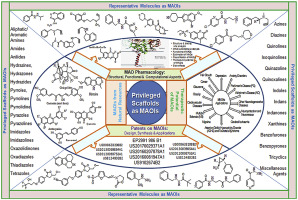European Journal of Medicinal Chemistry ( IF 6.0 ) Pub Date : 2018-01-04 , DOI: 10.1016/j.ejmech.2018.01.003 Avinash C. Tripathi , Savita Upadhyay , Sarvesh Paliwal , Shailendra K. Saraf

|
This review aims to be a comprehensive, authoritative, critical, and readable review of general interest to the medicinal chemistry community because it focuses on the pharmacological, chemical, structural and computational aspects of diverse chemical categories as monoamine oxidase inhibitors (MAOIs). Monoamine oxidases (MAOs), namely MAO-A and MAO-B represent an enormously valuable class of neuronal enzymes embodying neurobiological origin and functions, serving as potential therapeutic target in neuronal pharmacotherapy, and hence we have coined the term “Neurozymes” which is being introduced for the first time ever. Nowadays, therapeutic attention on MAOIs engrosses two imperative categories; MAO-A inhibitors, in certain mental disorders such as depression and anxiety, and MAO-B inhibitors, in neurodegenerative disorders like Alzheimer's disease (AD) and Parkinson's disease (PD). The use of MAOIs declined due to some potential side effects, food and drug interactions, and introduction of other classes of drugs. However, curiosity in MAOIs is reviving and the recent developments of new generation of highly selective and reversible MAOIs, have renewed the therapeutic prospective of these compounds. The initial section of the review emphasizes on the detailed classification, structural and binding characteristics, therapeutic potential, current status and future challenges of the privileged pharmacophores. However, the chemical prospective of privileged scaffolds such as; aliphatic and aromatic amines, amides, hydrazines, azoles, diazoles, tetrazoles, indoles, azines, diazines, xanthenes, tricyclics, benzopyrones, and more interestingly natural products, along with their conclusive SARs have been discussed in the later segment of review. The last segment of the article encompasses some patents granted in the field of MAOIs, in a simplistic way.
中文翻译:

特权支架作为MAO抑制剂的回顾与展望
这篇综述旨在成为药物化学界普遍关注的全面,权威,关键和可读的综述,因为它侧重于作为单胺氧化酶抑制剂(MAOIs)的各种化学类别的药理,化学,结构和计算方面。单胺氧化酶(MAO),即MAO-A和MAO-B代表了一类非常有价值的神经元酶,具有神经生物学的起源和功能,是神经元药物治疗中的潜在治疗靶标,因此我们创造了“神经酶”一词。”,这是有史以来第一次引入。如今,对MAOI的治疗关注涵盖了两个必不可少的类别。在某些精神障碍(例如抑郁和焦虑症)中的MAO-A抑制剂和在神经退行性疾病(例如阿尔茨海默氏病(AD)和帕金森氏病(PD))中的MAO-B抑制剂。由于某些潜在的副作用,食物和药物相互作用以及引入其他类别的药物,MAOI的使用有所减少。但是,对MAOI的好奇心正在恢复,并且新一代高选择性和可逆MAOI的最新发展更新了这些化合物的治疗前景。审查的第一节着重于详细的分类,结构和结合特性,治疗潜力,特权药效团的现状和未来挑战。但是,特权支架的化学前景如:脂肪族和芳香族胺类,酰胺类,肼类,唑类,二唑类,四唑类,吲哚类,嗪类,二嗪类,黄嘌呤类,三环类,苯并吡喃酮类以及更有趣的天然产物,以及它们的结论性SAR都已在后面的综述中进行了讨论。本文的最后一部分以简单的方式涵盖了在MAOI领域中授予的一些专利。











































 京公网安备 11010802027423号
京公网安备 11010802027423号